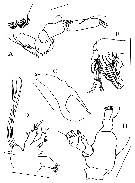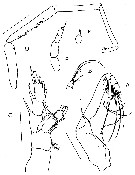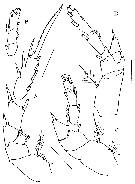|
|
 |
|
Calanoida ( Order ) |
|
|
|
Clausocalanoidea ( Superfamily ) |
|
|
|
Phaennidae ( Family ) |
|
|
|
Kirnesius ( Genus ) |
|
|
| |
Kirnesius groenlandicus Markhaseva & Semenova, 2005 (M) | |
| | | | | | | Ref.: | | | Markhaseva & Semenova, 2005 (p.40, Descr. M, figs.M) |  issued from : E.L. Markhaseva & T.N. Semenova in Mitt. hamb. zool. Mus. Inst., 2005, 102. [p.38, Fig.1]. Male (from 76°46'N, 7°29'E): A-B, habitus (dorsal and lateral, respectively); C, rostrum (ventral view); D, rostrum (left lateral view); E, posterior corners of prosome and urosome (right lateral view); F, right caudal ramus (ventral). Scale bars: 0.1 mm. Nota : Rostrum a well developed blunt plate with small chitinous semicircular ridge on the left distal edge. - Prosome 3.7 times longer than urosome. - Pedigerous somites 4 and 5 incompletely fused (suture clearly visible laterally). - Posterior corners as short lobes. - Caudal rami with 4 terminal setae, 1 short ventral seta and a small dorsal sensilla. - A1 nearly as long as body. Right A1 of 23-segmented; left one 22-segmented.
|
 issued from : E.L. Markhaseva & T.N. Semenova in Mitt. hamb. zool. Mus. Inst., 2005, 102. [p.39, Fig.2]. Male: left A1, segments 1-6 (ancestral segments I-VIII). Segment 2 is a complex of ancestral segments II-IV. Scale bar: 0.1 mm. Nota : A1 nearly as long as body with 2 brush-like aesthetascs in proximal part on 2nd and 5th segments ; right A1 23-segmented ; left A1 22-segmented.. Rem : Antennulary aesthetascs with brush-like tips are rare in the subclass Copepoda. Several examples of such aesthetascs are known in the poecilostomatoid males Pachos punctatum (Claus, 1863) and P. tuberosum (Giesbrecht, 1891) ; antennulary aesthetascs similar to brush on its tip are also observed in some fresh-water Cyclopoida males. Since Giesbrecht (1892) the trithek/quadrithek pattern of antennulary armament is considered typical of copepod females and males. The trithek pattern is 2 setae plus 1 aesthetasc ; quadrithek are 2 setae plus 2 aesthetascs. It was suggested that the doubled aesthetascs of the quadrithek are an adaptation of calanoid males to search for females in the pelagic environment (Ferrari & Benforado, 1998). Kirnesius groenlandicus demonstrates a setation typical of the copepod quadrithek pattern : articulated segment 2 is a complex of fused ancestral segments II-IV and bears 6 setae plus 4 aesthetascs (found also in other males of families possessing sensory setae on Mx2). In this species, however, 1 of 4 aesthetascs is brush-like, with a well defined head supplied with long filaments ; another aesthetasc with brush-like tipi s sutuated on articulated segment 5 (ancestral segment VII) which has a typical quadrithek pattern (2 setae plus 2 aesthetascs. While sensory setae on Mx2 and Maxillipedal syncoxa of calanoids are assumed to have originated from sclerotized setae (playing the role of chemoreceptors and may be directly used for capture and manipulation of food particules; those which are worm-like are condidered to have the function of \"more general detection\", while brush-like aesthetascs are \"more specific \" in detection of chemicals, see Nishida & Ohtsuka, 1997, the origin of antennulary aesthetascs is not so clearly understood (see Boxshall & Huys, 1998), we often cannot distinguish between aesthetascs that have originated from setae and those of other origin.
|
 issued from : E.L. Markhaseva & T.N. Semenova in Mitt. hamb. zool. Mus. Inst., 2005, 102. [p.41, Fig.3]. Male : right A1, segments 1-5 (ancestral segments I-VII). Segment 2 is a complex of ancestral segments II-IV. Scale bar: 0.1 mm.
|
 issued from : E.L. Markhaseva & T.N. Semenova in Mitt. hamb. zool. Mus. Inst., 2005, 102. [p.42, Fig.4]. Male: A, right A1, segments 6 and 7 (ancestral segments VIII and IX); B, right A1, segments 8 and 9 (ancestral segments X-XII and XIII); C, right A1, segments 10-17 (ancestral segments XIV-XXI); D, right A1, segments 18 and 19 (ancestral segments XXII and XXIII); E, right A1 segments 20-23 (ancestral segments XXIV-XXVIII); F, left A1, segments 18 and 19 (ancestral segments XXII-XXIII and XXIV). Scale bar: 0.1 mm.
|
 issued from : E.L. Markhaseva & T.N. Semenova in Mitt. hamb. zool. Mus. Inst., 2005, 102. [p.44, Fig.5]. Male: A, A2; B, Md (mandibular palp); C, Md (gnathobase); D, Mx1; E, Mx2. Scale bars: 0.1 mm. Nota : A2 : coxa and basis with 1 seta each ; exopod 7-segmented with 0, 2, 1, 1, 1, 1, and 3 setae, about 1.9 times as long as endopod ; 1st endopodal segment witout setae, 2nd with 6+1 and 6 setae. - Md gnathobase with 5 spine-like teeth, without articulated seta. ; endopod 2-segmented. - Mx1 : praecoxal endite with 7 terminal spines ; coxal and proximal basal endites each with 2 setae, distal basal endite with 4 setae ; endopod with 3 setae ; exopod with 8 setae ; coxal epipodite with 5 setae. - Mx2 : proximal praecoxal endite with 5 setae, distal praecoxal endite with 3 setae ; proximal coxal endite with 3 setae each, distal coxal endite and proximal basal endites with 3 setae, of these, 1 seta is more sclerotized ; distal basal endite plus exopod with 8 sensory setae (6 longer worm-like, 1 shorter worm-like and 1 shorter worm-like with bifurcated tip.
|
 issued from : E.L. Markhaseva & T.N. Semenova in Mitt. hamb. zool. Mus. Inst., 2005, 102. [p.45, Fig.6]. Male: A, Mxp; B, Mxp (endopod distal segments 4-5); C, P1; D, left P5; E, right P5; F, right P5 (exopodsegments 2-3). Scale bars: 0.1 mm. Nota : Mxp : syncoxa with 1 sclerotized seta on proximal praecoxal lobe, 1 long sensory and 1 short sclerotized setae on middle lobe and 1 sclerotized seta on distal praecoxal lobe ; coxal lobe with 2 setae (1 long and 1 small and short) ; basis with 1 medial seta, 1 small sensilla near its base, and 2 setae distally ; endopod 5-segmented with 4, 4, 2, 3+1 and 4 setae, respectively. - P1 : basis with medial seta strongly curved ; lateral lobe of endopod without denticles. - P5 : uniramous, strongly asymmetrical, 5-segmeted on both sides ; left leg much longer than urosome, 2nd segment (basis) longest, with row of spinules along medial margin, segment 5 (exopod segment 3) with a thin and terminal spine and a row of spinules subdistally.
|
 issued from : E.L. Markhaseva & T.N. Semenova in Mitt. hamb. zool. Mus. Inst., 2005, 102. [p.47, Fig.7]. Male: A, P2 (without endopod); B, P2 (endopod segments 1-2); C, P3; D, P4. Scale bars: 0.1 mm.
| | | | | NZ: | 1 | | |
|
Distribution map of Kirnesius groenlandicus by geographical zones
|
| | | | Loc: | | | NE Greenland Sea (Knipovich Ridge) | | | | N: | 1 | | | | Lg.: | | | (951) M: 1,6; {M: 1,60} | | | | Rem.: | hyperbenthic (3480 m).
Markhaseva & Semenova (2005, p.48) hypothesize that brush-like aesthetascs on the proximal segments of the male antennule have developed to achieve an improved search for females in conditions of low abundances of hyperbenthic animals. However, it is not clear then, why they are also present in other copepod species (fresh-water cyclopoids with brush-like aesthetascs), which usually do not show low abundances. | | | Last update : 27/03/2016 | |
|
|
 Any use of this site for a publication will be mentioned with the following reference : Any use of this site for a publication will be mentioned with the following reference :
Razouls C., Desreumaux N., Kouwenberg J. and de Bovée F., 2005-2025. - Biodiversity of Marine Planktonic Copepods (morphology, geographical distribution and biological data). Sorbonne University, CNRS. Available at http://copepodes.obs-banyuls.fr/en [Accessed January 02, 2026] © copyright 2005-2025 Sorbonne University, CNRS
|
|
 |
 |










